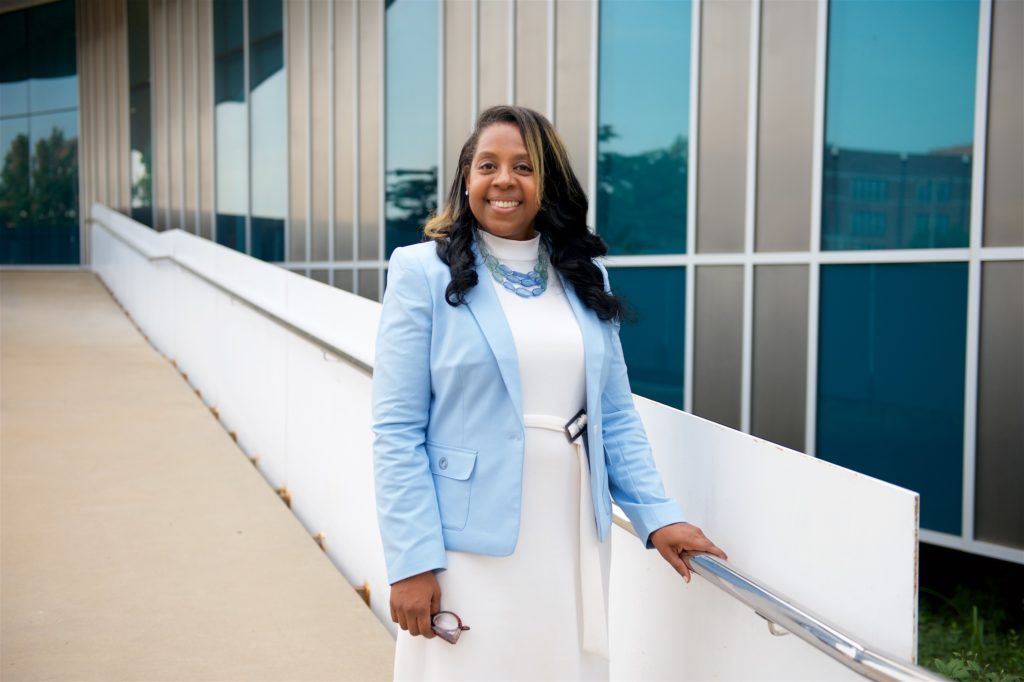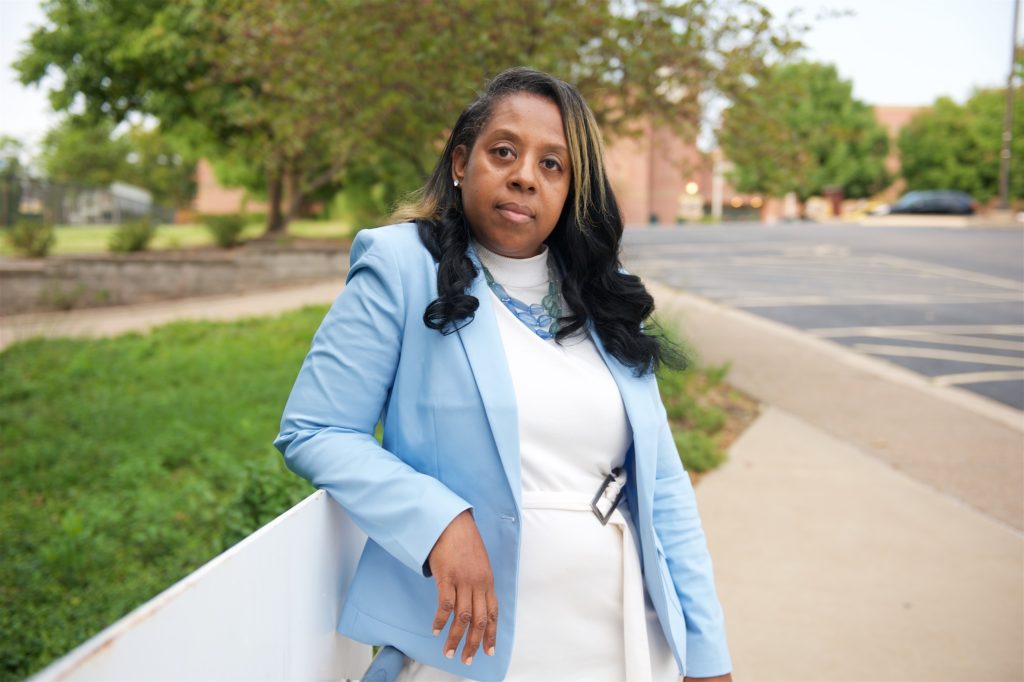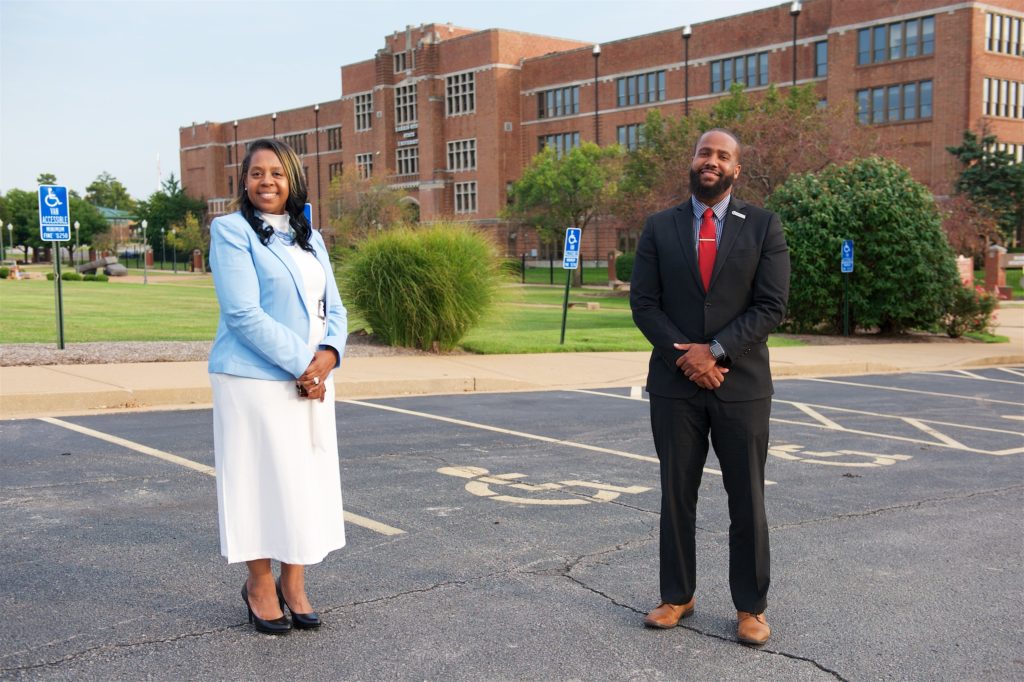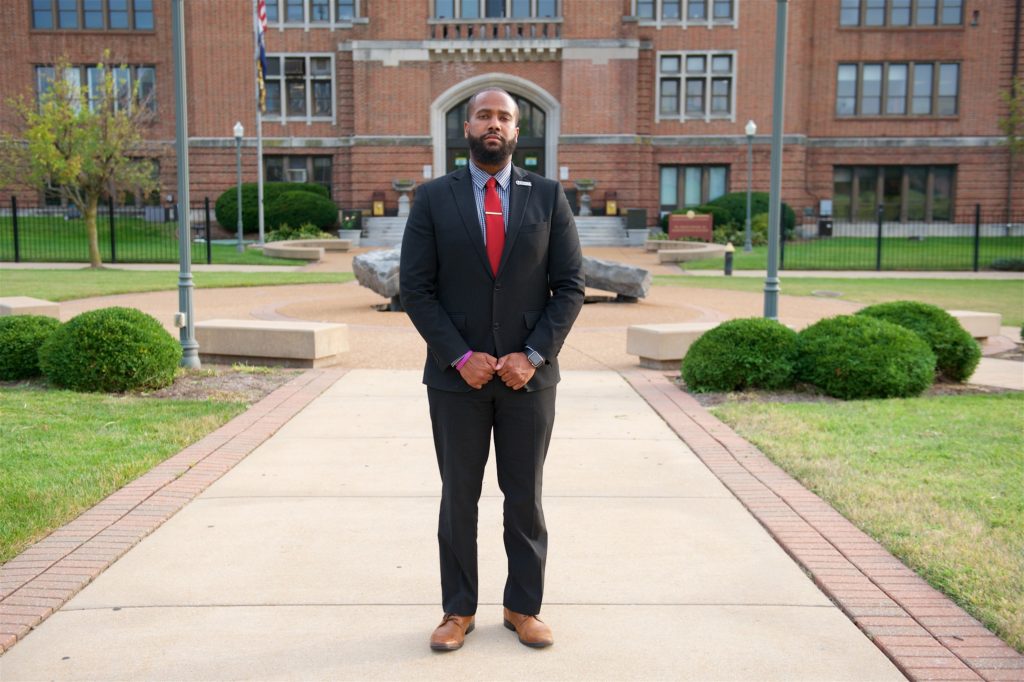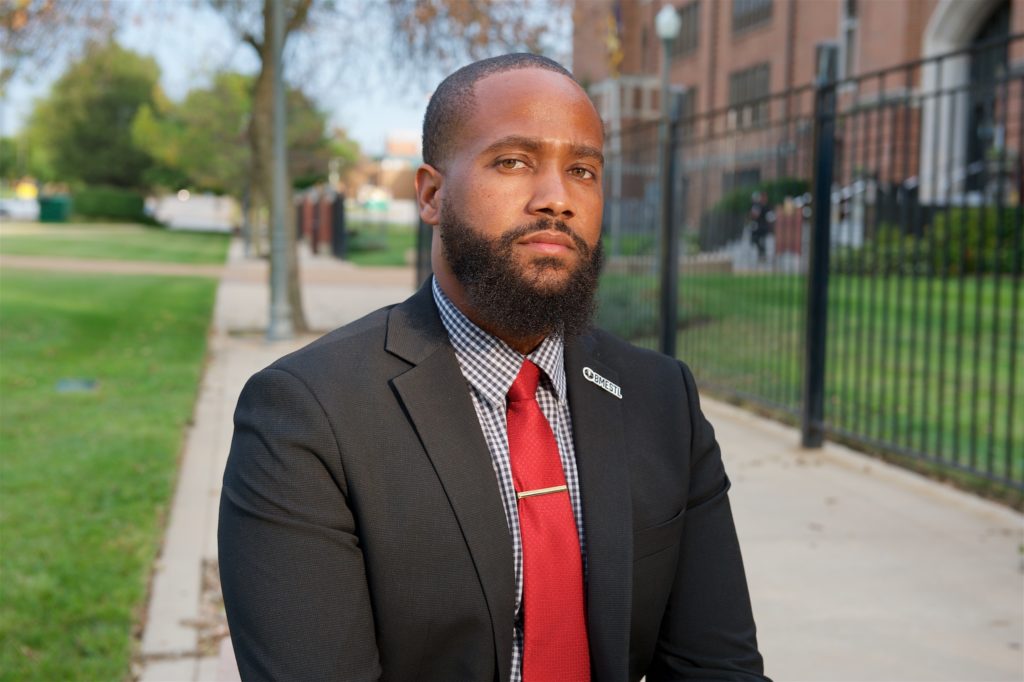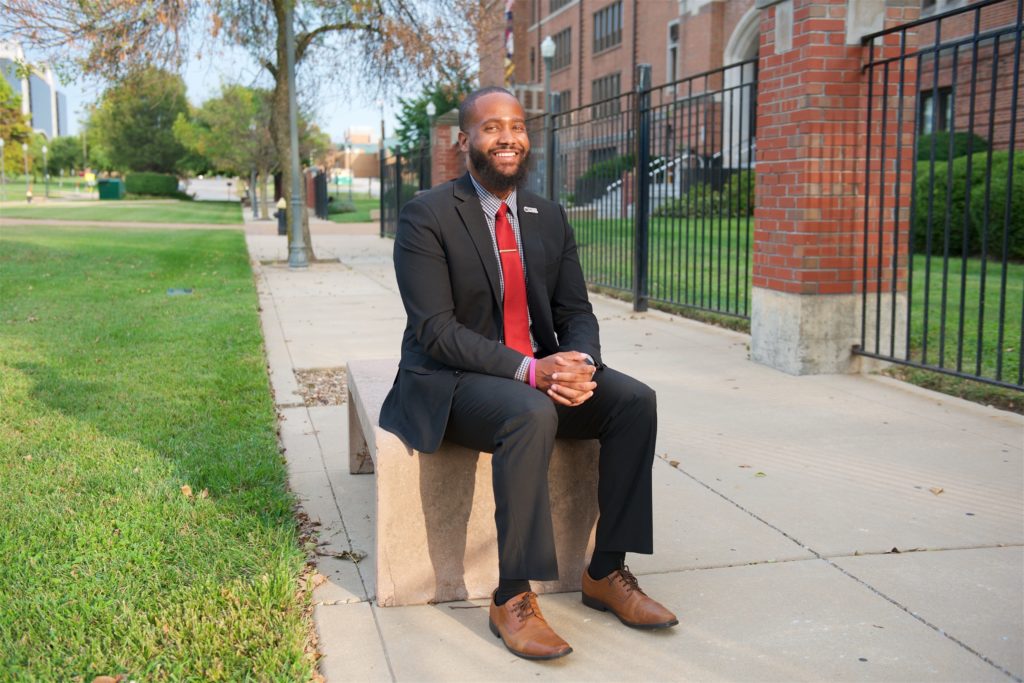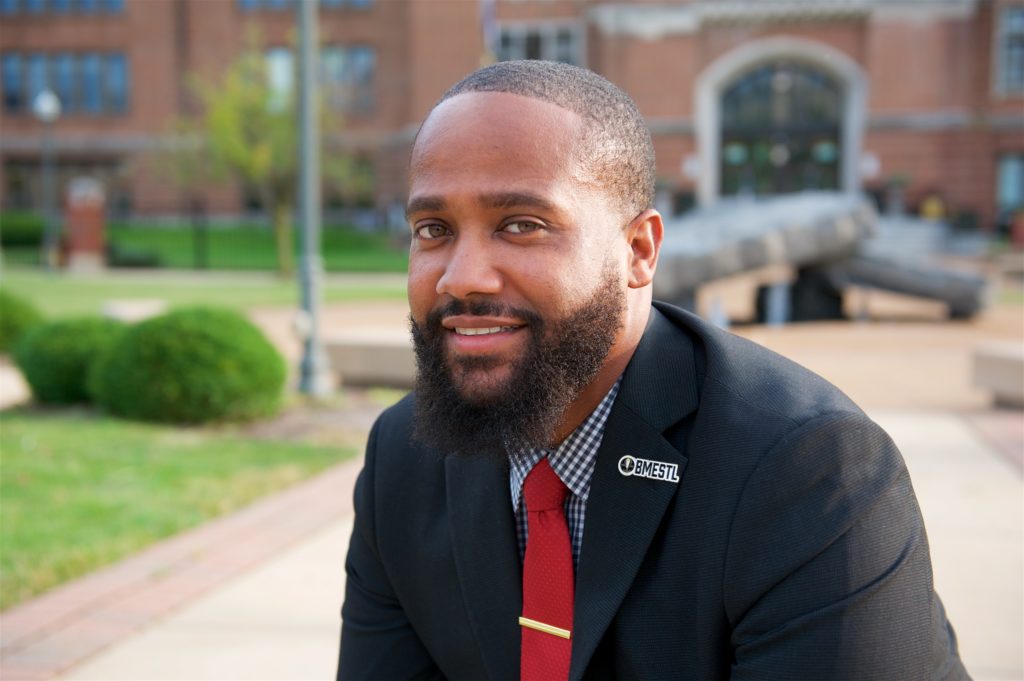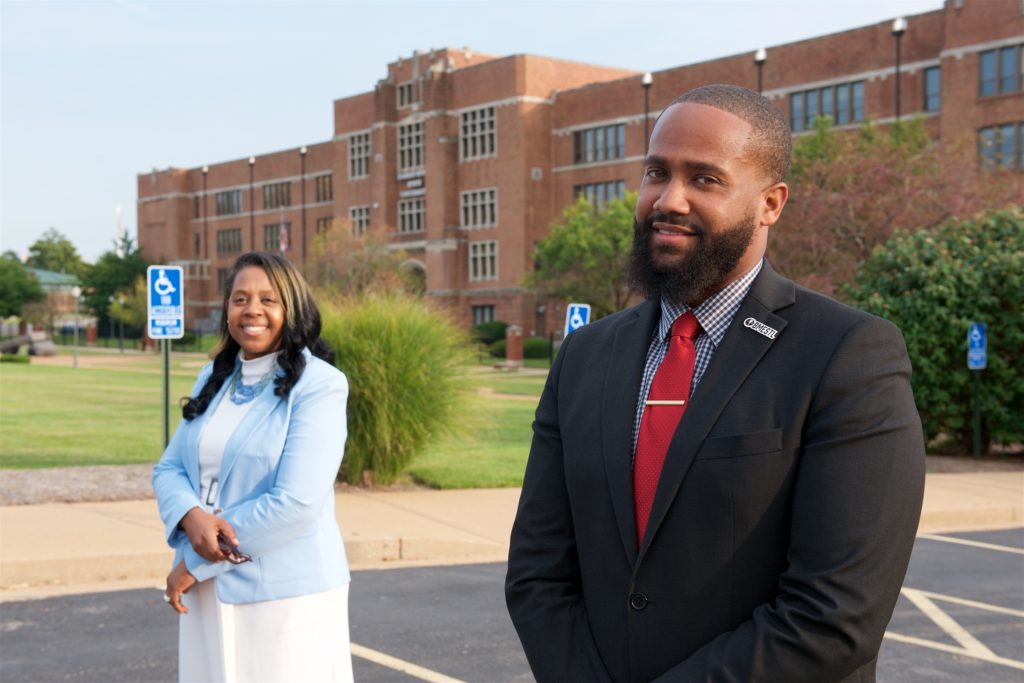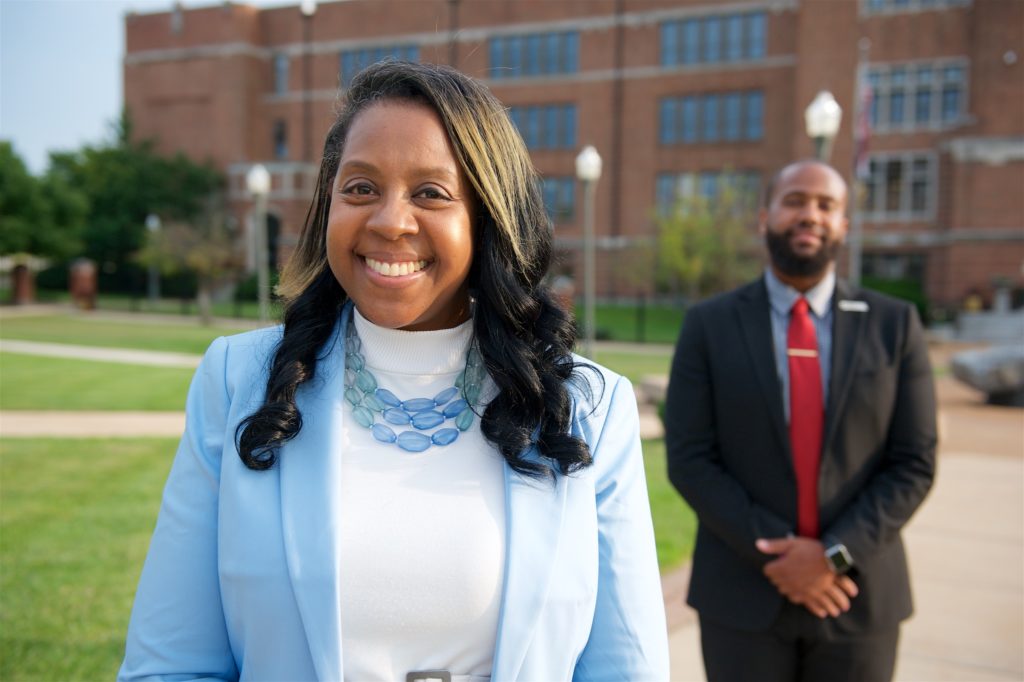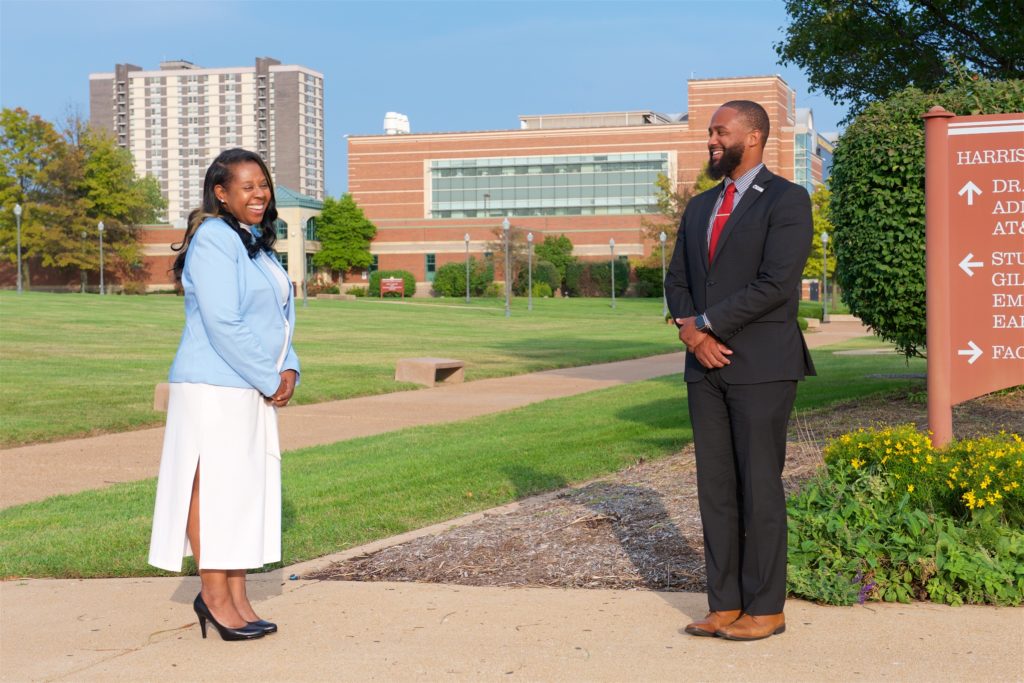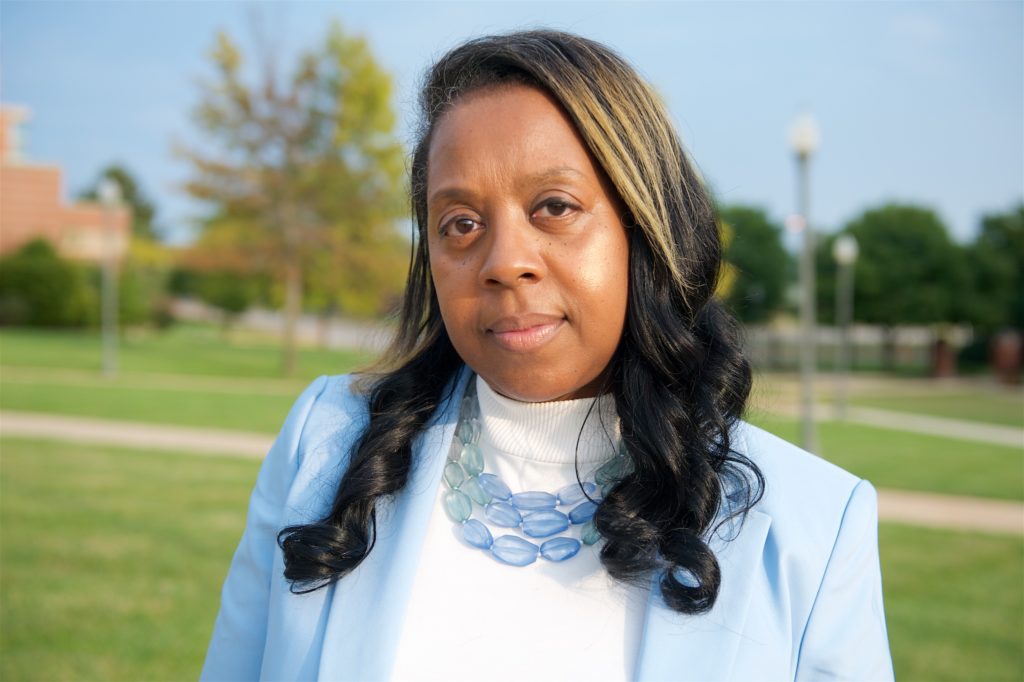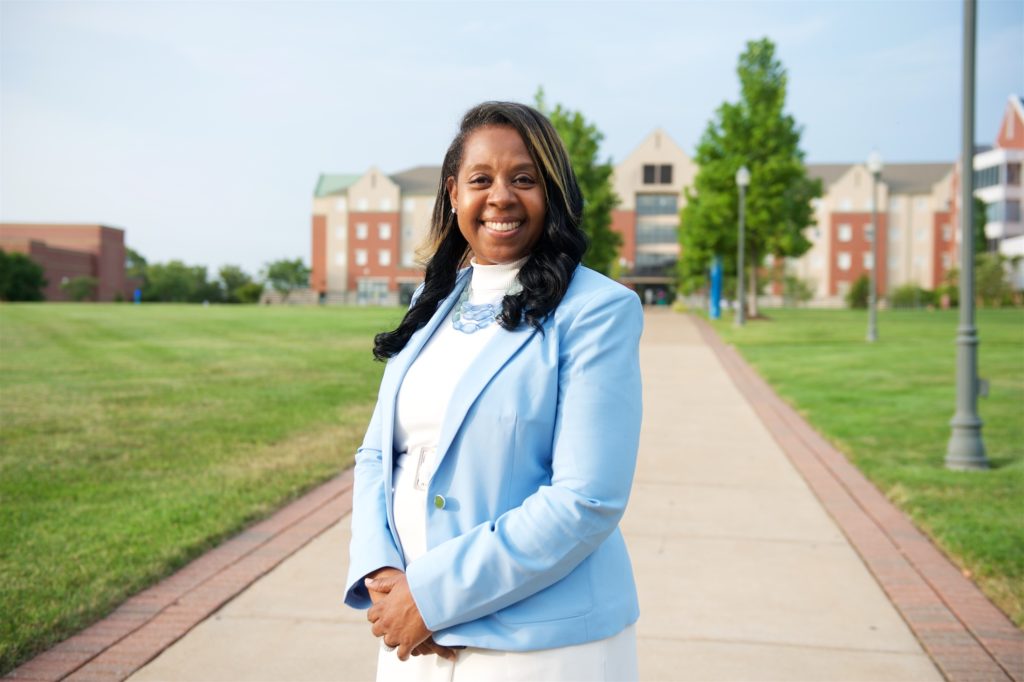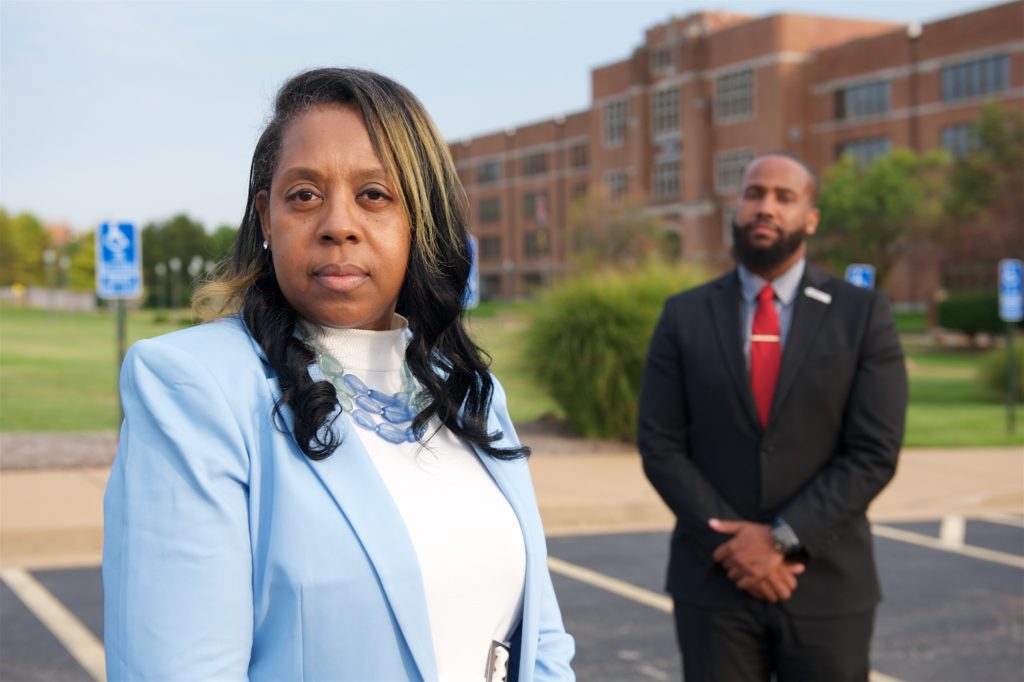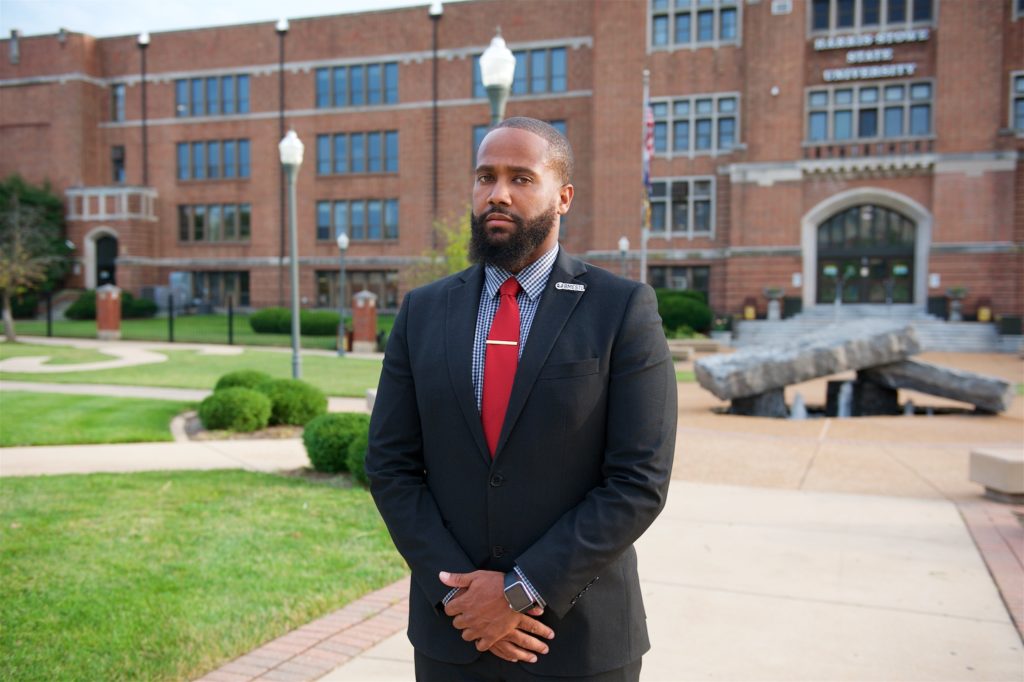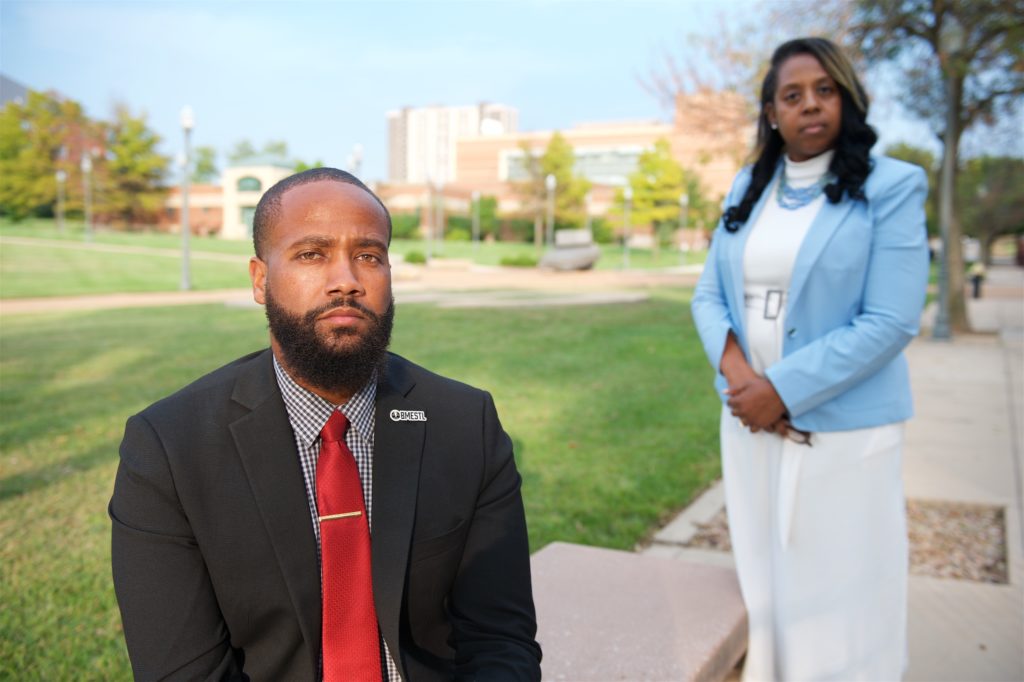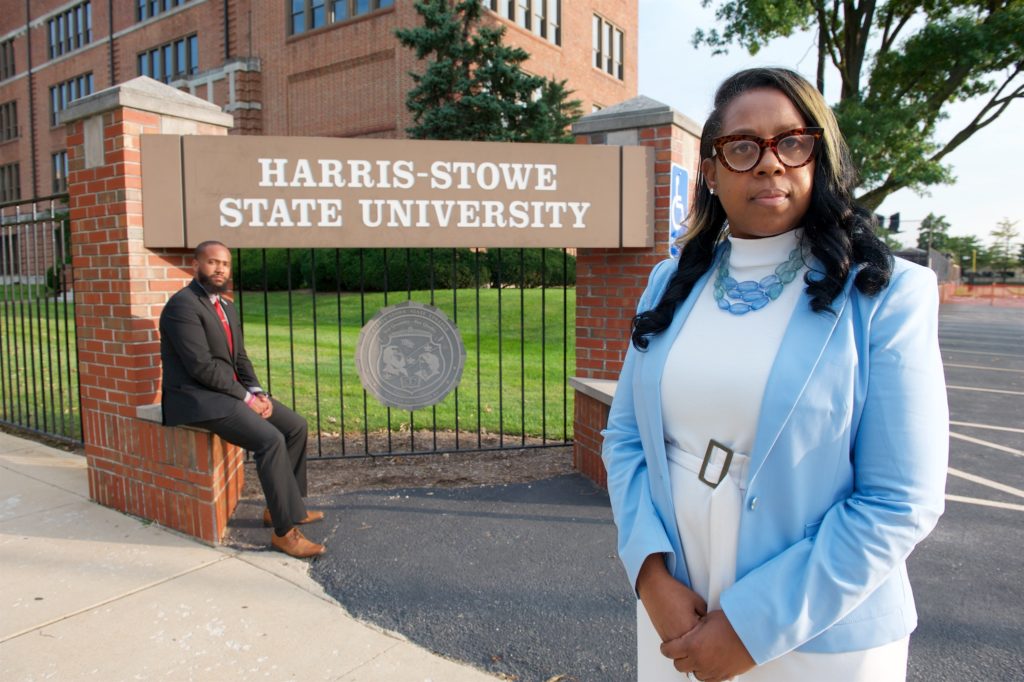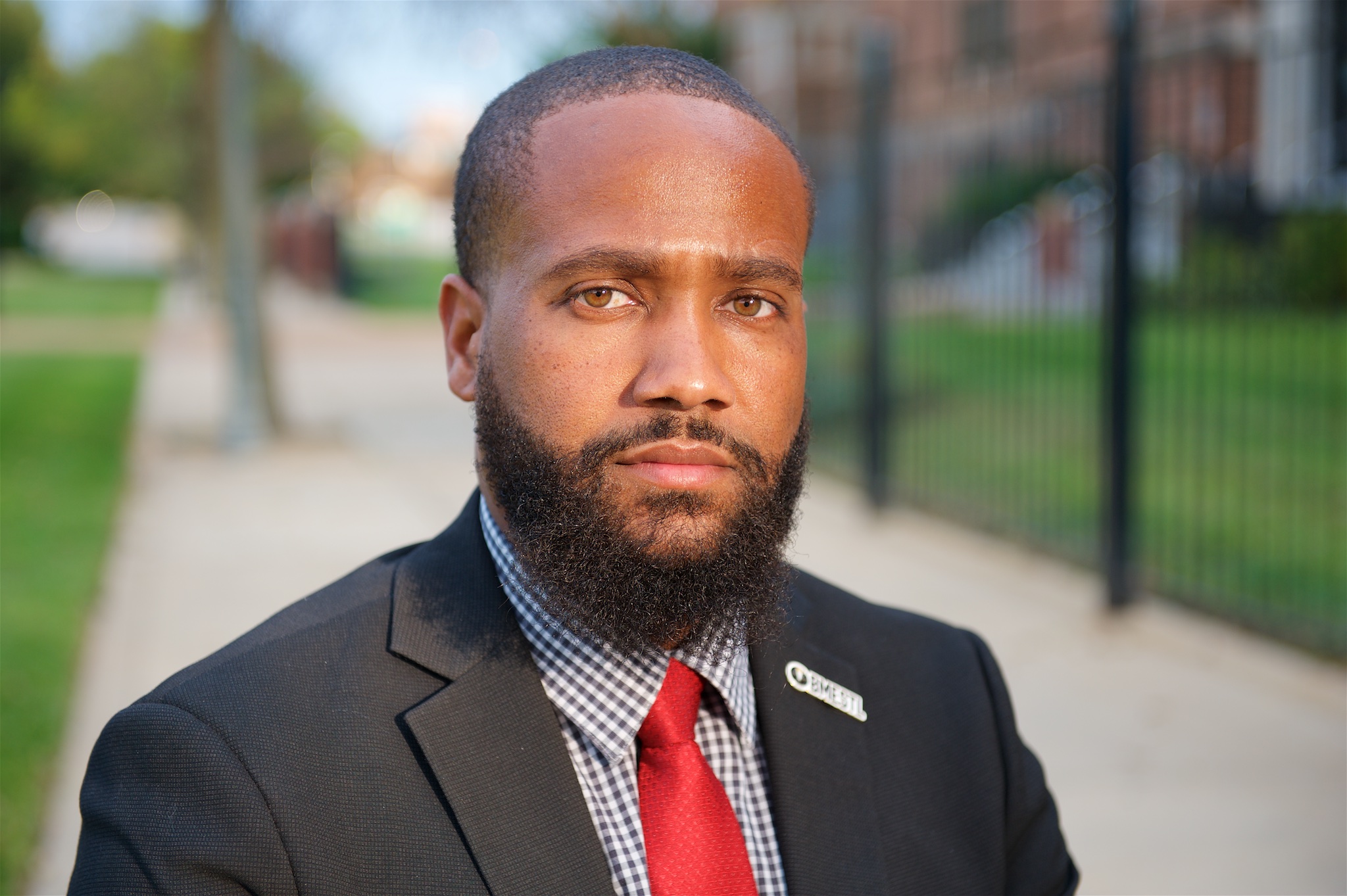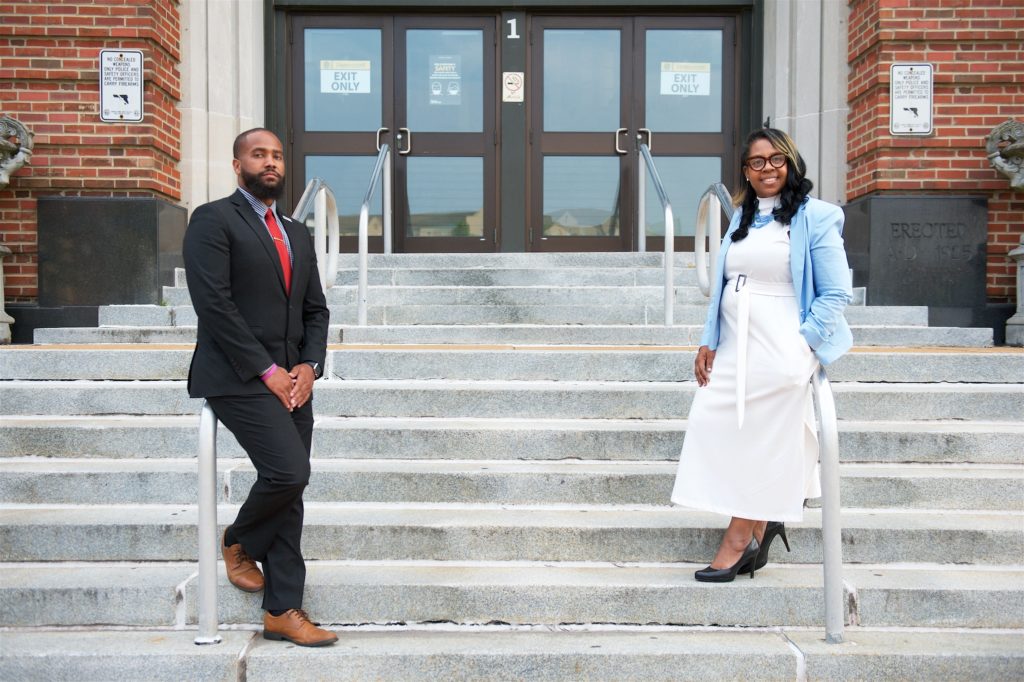Dr. Nicole Evans and Dr. Howard Fields
Photostory by Lindy Drew / Humans of St. Louis
Dr. Nicole Evans: I have been a charter school principal, a public school principal, and an educator all within the City of St. Louis. I’m also a product of Saint Louis Public Schools. So, I have been able to have an inside and outside view of St. Louis in terms of education. In addition, I’m a TK — a teacher’s kid. That said, I was able to hear conversations about the landscape growing up in the early 70s as a student of SLPS. Right now, I am involved in helping build a stronger pipeline for teachers in our teacher preparation program at Harris-Stowe State University. My dad was an educator. He earned his degree here at Harris-Stowe. I am an educator. I earned my degree here at Harris-Stowe. It’s come full circle. But, when my dad was coming through this university, if you were worth your salt and you were a teacher of color in St. Louis, you basically got your preparation from here. When I came through, things began to take a turn. I got a great education, but things began to whittle off since then. Now, we are back in the rebuilding phase. We want to make sure teachers of color, in particular, will know that before they leave, they’ll have been taught well from a very well-prepared educator.
Education is everybody’s business. It takes all of us to do this well for the students in the City of St. Louis. It’s about professionalism and accountability. We have, as Gloria Ladson-Billings calls it, an education debt — a debt owed to the children of St. Louis. And there are things we’re doing and building to start to pay that debt down. So, at Harris-Stowe and within the educational community, we are reaching out to partners — to people who will think alike and with us. One of those groups is EdHubSTL, an innovative space that gathers educators together to grapple with the problems we are facing. I’m also a part of Equitable Ed, a team of myself and Dr. Latoshia Ellis, where we support districts, schools, parents, teachers, and students in the area of equity and learning about anti-bias anti-racist (ABAR) development. It’s all about equity. What we’re saying is, “We’re gonna do whatever to support the children in St. Louis and reduce that debt we owe to them.”
We need to do more, and we need to do it now. We need to link arms, form partnerships, and avoid being distracted by conversations such as charter versus public.
Dr. Nicole Evans
The tricky part is, it takes time. And the numbers are showing us that there’s a sense of urgency around equity in education. We need to do more, and we need to do it now. We need to link arms, form partnerships, and avoid being distracted by conversations such as charter versus public. I’m not saying there isn’t validity to some of these issues, but we have to do whatever it takes to get our students, particularly in the City of St. Louis, prepared for the next step in their lives. And we need to bring our children to the table. What we’ve been missing are student voices. They have something to say. We need to count them as stakeholders and as part of the solutions. We need to do some radical listening for our students and ask them, “What is it that you need?” Sometimes they won’t know. But just giving them the opportunity to have a seat at the table is something we need to do more of.
We’re looking to create a new vision while building upon the strong foundation of where things were when my father earned his degree here. We want to embed the concept of Sankofa, an African tradition that says to go back to the past and only bring forth those lessons you’ve learned to build a stronger future. In order to do that, we’re creating a container and reaching out to stakeholders in order to do things like the Superintendent and School Leaders Advisory Council meeting we held where we invited all of the educational leaders in the St. Louis region, Illinois, and further out in Missouri to come to the table. We implored them to come and tell us what their needs are so we can prepare our teachers and educators to meet them. That is where Dr. Howard Fields comes in because he is helping to prepare those teachers. Dr. Fields is one of our esteemed professors, and he works diligently to produce educators ready to tackle the challenges and opportunities of teaching. He and his co-leaders are Black males in education, and we need more of them in this space. Our students deserve a window in the mirror. Hopefully, through Dr. Fields and other organizations doing this work, we will make progress.
Dr. Howard Fields: I was a student in the Riverview Gardens School District from kindergarten until November of my senior year. Then I transferred to the Mehlville School District, where I graduated. I reference my years as a public school student because my career path has followed such a transition from urban to suburban schools. I worked at Riverview Gardens for nine years as a teacher, assistant principal, and principal. My last three years were at Koch Elementary School. If you’re familiar with Canfield Green Apartments, you know that all of the students who live there, if they were in elementary school and if they attended their neighborhood school, they attended Koch. And two days before I started my first principalship, Michael Brown was shot and killed right down the street from my building. That was year one. Year two, Jamyla Bolden, one of my dearest fourth grade students, was the young lady who was shot and killed while reading to her mom in their home.
These are just some of the challenges of being an administrator and leader in urban education. Then I transferred and became a principal in the Webster Groves School District at two different schools. Dr. Henry Givens Jr. Elementary School was previously the Webster Groves Elementary Computer School, but in my first year, we went through a process of renaming the school after Dr. Givens, the only person to lead two historically Black colleges and universities at one time: Harris-Stowe and Lincoln University – Missouri. (He made the wise decision to continue to be with Harris-Stowe.) I think his work speaks for itself. So, to be able to name a school after him, given he started both his teaching career and administrative career in Webster Groves, was a humbling experience. After three years there, I am now the Assistant Superintendent of Human Resources in the Kirkwood School District.
All I see across the board are inequities. And using the word inequity is not even big enough.
Dr. Howard Fields
All I see across the board are inequities. And using the word inequity is not even big enough because we can talk about resource inequities, racial inequities, inequities for some of our students who qualify for free and reduced-price meals, or inequities for those who receive special education services. When I was a student and transferred from Riverview Gardens to Mehlville High School, I quickly noticed how some of the course options were different. For example, the ability to build actual computer software applications in the early 2000s was unlike any experience I previously had. I think about my time working in different school districts and sometimes I was the administrator, but I was also the counselor and the social worker. And while we had counselors and social workers, we still had to do whatever it took by any means necessary to meet the needs of our entire population. The same is true as I reflect on the variance in resources when leading a building in different school districts. Most notably, job postings. It’s not uncommon for urban schools to receive 15 or 20 application submissions for certain positions. In Webster Groves, getting 100 to 300 applicants for a position was the norm. So, inequities are just part of education across the board. And unless there’s a deliberate and systemic approach to dismantling all forms of inequities, they will continue to persist.
Being a Black male leader who will always advocate for what’s best for students and the communities they call home, while also empowering others to do the same, I’ve learned to expect pushback as a consequence of this work. People might love me when I’m great, but when I started initiating changes in some predominantly White spaces, sometimes folks didn’t speak to me in the hallways. We will all be faced with the decision to either succumb to the physical and mental toll of being a leader or to walk through it and lead courageously. While I have certainly faced some challenges, working with incredibly talented and supportive colleagues enables me to continue to learn and grow. I had the privilege of being named the 2020 State of Missouri Elementary Principal of the Year. I’m one of about 50 educators across the entire nation and the only one from Missouri elementary schools to receive this honor. But I don’t feel like I’m an anomaly. Another Black male and fellow leader from Kansas City, Eric Johnson, was the 2020 Secondary Principal of the Year in the State of Missouri. And, D.C., Darrion Cockrell, a Black male educator in Lindbergh at Crestwood Elementary School, was named the 2021 Missouri Teacher of the Year. The effectiveness of Black males in the field of education is apparent, even though we make up less than 2% of educators here in Missouri and nationally. This also speaks to the need for affinity groups. We must create a support system and celebrate each other’s successes and contributions. My stance is that if you’re doing great work and I don’t know you, it’s on me to reach out to, learn from, and connect with you because I know some of the challenges you may be going through in this field.
Black educators often feel like we have to walk the straight and narrow. And given all of the burdens we shoulder, celebrating our own accomplishments becomes an afterthought. So Black Males in Education St. Louis (BMESTL) was started in May 2019. We’ve done a tremendous amount of work and it’s been successful, but the thing people don’t realize is that this is also my self-care. Whenever I perish, it would be my hope that people will say, “Dr. Fields was authentic and all about making sure brothers knew the importance of self-care.” I want to take those values to my grave, because when you take care of yourself — physically, mentally, and spiritually — you typically live with less stress and are able to be much more effective for your family, staff, students, and community. Such an outlook is what connected me to Dr. Darryl Diggs, my organization’s co-founder. He had to navigate some race-related issues during his time as an administrator in the Parkway School District, and it left him broken. He even considered leaving the field of education. But through co-founding BMESTL, he has been instrumental in the recruitment, development, support, and mentoring of Black males in education.
Together, we’ve engaged with a number of brothers across the St. Louis region and helped start the Kansas City affiliate, Black Males in Education Greater Kansas City. Then, in November 2019, we had the crazy thought of gathering 200 to 300 people in a space to discuss matters Black educators, both men and women, face. We would soon find out that interest in the event exceeded our expectations. By February 2020, we had over 1,400 registered participants and over 1,200 in the building for the State of Black Educators Symposium. Now, we’re starting to methodically roll out the next step for BMESTL and that means talking about policy. We are fortunate to have Dr. Evans at Harris-Stowe and some other colleagues at other places because we all breathe equity and breathe the work we’re doing. But in the event that we leave one day and go somewhere else, we don’t want anything we’ve built to just fall apart. History has shown us the importance of policy changes to sustain our efforts. So the 2021 State of Black Educators Symposium will be virtual and emphasize the importance of policy work.
There are a number of things that allow me to continue to go full speed. In addition to family, getting a chance to partner with Harris-Stowe contributes. I remember my first semester working at HSSU, I went into the classroom and couldn’t stop smiling. One student eventually said, “We’ve been in this class for 30 minutes. Why are you still smiling?” I responded, “I don’t think you all understand how happy I am to see you.” Being at an HBCU, they felt as if they were lucky to have me there and they were asking all of these questions about my experiences. That means a lot to me to this day. What’s important to note is that this was around the time I was also working in a space where making necessary systemic changes for students was incredibly draining work. The pushback and challenges I endured required me to constantly revisit my “why?” Engaging with these students, in particular, allowed me to properly put things into perspective.
The other piece I’m super excited about is the policy work because BMESTL is leading the creation of a regional memorandum of understanding (MOU). It is made up of four pillars: governance; curriculum and instruction; personnel; and student, parent, and community support. We believe it can be an initial step in regional action, and we want all public schools, private schools, higher education, nonprofit organizations, and others to join. If we’re serious about IDEA — inclusion, diversity, equity, anti-bias, and anti-racism —and serious about making some strides in our educational organizations, then let’s implement these action steps.
We are building meaningful partnerships, not just ones that look good on paper. Ones that have real goals to move forward. With this work, we have got to roll up our sleeves and get in the trenches.
Dr. Nicole Evans
Dr. Nicole Evans: The next movement and generation is saying, “We want action.” We are no longer going to just admire the problem. The problem is here, the debt exists. We understand that. And because education is everybody’s business, we are now pushing for people to do things, which is why the policy is important and the IDEA MOU is important. We want to center all of those. That’s what I was referring to when I said we are creating the container. We are building meaningful partnerships, not just ones that look good on paper. Ones that have real goals to move forward. With this work, we have got to roll up our sleeves and get in the trenches.
Harris-Stowe State University has deep roots in the educational arena in St. Louis. That is not going to stop. But the teacher pipeline and the teacher pool is very shallow. We are trying to be innovative, thinking of programs so we can assist educators and make sure they are highly qualified. One of the new programs I am assisting with is the Accelerated Certification Track Program. So if someone has a bachelor’s degree in an area close to the educational field, then we have a one-year online program for folks to get their certification. Again, they are learning from professors such as Dr. Fields on how to be effective and highly qualified. We also have the Grow Your Own program in which high school students from the Confluence Academies are on campus taking classes. And when they’re done, they will go back to Confluence and become teachers within that district. We are creating possibilities like these to move the needle forward for educational progress in the City of St. Louis.
I grew up in the Blumeyer housing project. I remember Carver Elementary was my neighborhood school right across the street from the old Vashon High building, and all of the students were Black. What I remember is there was a great respect for educators and principals. What I remember is what Lisa Delpit calls “warm demanders.” And those professionals were warm demanders. They told us stories about their lives, and they demanded that we do well and perform. They pushed us. If they said, “Alright, don’t make me call your mama,” we knew what that meant. That wasn’t a threat. We understood they wanted us to get somewhere. They were role models to us. I don’t know that I necessarily heard the word “achievement” coming out of their mouths, but I knew what they were pushing us towards. When it came to standardized tests, they would prepare us for those, telling us, “You need to play the long game. Don’t just think about what’s here right in front of you. Think about your future.”
I also remember learning with people who did not look like me and learning from people who did not look like me. That didn’t happen until middle and high school. I attended Metro High School in Saint Louis Public Schools, which is a gifted school. And that’s when my world really opened in terms of learning alongside students who might not have looked like me. But what I will say is, I was most supported when I was with students and teachers who looked like me. There were a few teachers who identified as white, who had been racialized as white, who helped me learn also, but there was something different in their classrooms. I would not say all of those teachers were warm demanders. I would call every one of my Black teachers a warm demander.
My father and mother were low-income, young folks, together and married. They made the decision that he was going to be the one to finish his college career and get his degree. So we found ourselves growing up within that housing project, but I would not even call it that. It was a community. In that community, there was poverty. And what my parents understood, what the teachers understood, was that the success of students in most cases was school dependent. Most of the families in the Blumeyer community likely didn’t have a father present in the home. Or, if they did, they did not have a father with a college education. As a matter of fact, my father was known as Daddy John because of the lack of Black fathers living in the community. So, if indeed the success of students was school dependent, then we needed high quality teachers. That was important. That is where Harris-Stowe State University came into play back then — producing teachers who were high quality. And today, we continue to really deepen that commitment that has always been there.
Teachers are asking for more resources and support. They do not want data to be a hammer. They do not want testing to override what should be offered to children. We want every child to meet their fullest potential, whatever that is. And teachers want to be able to guide them without data being weaponized against them or students, like, “See? There’s an education gap. Those students can’t learn.” They also don’t want zip codes to determine the zenith of the students. Your zip code should not keep you from being a shooting star and reaching your full potential. And in the educational landscape, that appears to be the case. “Oh, you live in THAT community? Oh, that’s not a good school.” Location should not be a barrier in this equity piece.
What happens when people do that? They begin to turn their backs. That’s why I keep centering how education is everybody’s business. Corporations should be giving back to those communities and having mentorship programs. Are you reaching into the schools and saying, “That’s my next CEO. That’s my next COO. What am I doing to support and help them?”
We are now living in the time of a pandemic in which people are actually hearing what we’ve been saying. The problem, as Luvvie Ajayi says, is that we’ve been in a global community that’s been asking us to whisper, but we want to yell. And when we’ve been yelling, people have not heard us. So educators are saying, “Give us the resources we need. Don’t penalize us with test data. And let us get back to being warm demanders. Let us push the students in the ways that we know and put our arms around them.” If 2020 is showing us anything, it’s that we can do things differently. We have been standing in our own way. Let’s get to the table, stop admiring the problem, and move to action.
Dr. Howard Fields: One of the first things people look for on Zillow or other apps when they are relocating to the St. Louis area is the ratings of the schools. In order to truly measure the quality of a school, we must address resource inequities. Dual credit enrollment, course options, and standardized test scores are all important measures that I support, but we must also consider these through a critical lens. A few years ago, a lot of people looked down on an urban school district because 18% of their students scored proficient or advanced in math. Approximately 95% of the students there are Black. Conversely, in one of the “best districts,” only 17% of their Black students scored at the proficient or advanced level on the same assessment. I am in favor of performance report cards for schools and districts, but I would just like for us to consider collecting data to form a 360-degree view.
As practitioners, we discuss how the system is doing exactly what it was designed to do — reward some areas for being affluent and penalize others for not. This goes completely against the belief that all students deserve a high-quality education regardless of their race, socioeconomic status, abilities, or where they live.
Dr. Howard Fields
For instance, what if we also measured the frequency of race-based issues and incidents within schools? Or, what if we measured how often underrepresented students were visible in non-subservient contexts within the curriculum their schools use to teach them? It’s not about criticizing, but, given all the metrics of significant value, few if any nonurban districts have evidence to support they are benefiting large populations of underrepresented students better than the same urban districts that are criticized for academic achievement. As practitioners, we discuss how the system is doing exactly what it was designed to do — reward some areas for being affluent and penalize others for not. This goes completely against the belief that all students deserve a high-quality education regardless of their race, socioeconomic status, abilities, or where they live.
We’re not looking enough at the impact race is having in school systems. Race-based incidents are going to continue to happen in schools, particularly in predominantly White institutions. How are we supporting our students when this occurs? This is part of the reason I worry about underrepresented students, regardless of if they are in an urban, rural, or suburban school. Between microaggressions, blatant acts of racism, sexism, and other barriers that may be a result of their ability or family resources, we are perpetuating a system that normalizes traumatic experiences that occur in our schools. When students have to deal with slurs from other students as a result of their race, gender, sexuality, or any of their social identities, we must ask, how are they going to deal with the hurt and pain years down the line? As a school, we have the responsibility to prevent these occurrences and provide the necessary support to overcome these issues. But if we are not required to report these matters or held accountable in addressing them, we send the message to our students that some of them don’t matter. This is critically important to be aware of as we approach the 2020 general election and attempt to transition our students back to in-person learning. We know some of them are struggling at home, and we need to get them back to school. At the same time, the harsh reality is that some of our students have not experienced trauma, particularly race-based trauma, because they’ve been at home with their families and free from an inequitable system.
If I can add to that, I am a person who operates within visuals. In terms of data, we’re swimming in it. You can’t find any school that’s not. But, we are not scuba diving and we need to start. If we go deeper, we will discover that the top of the water looks very different from what’s happening down there. There’s so much more life. To be quite frank, the only reason why we’ve seen some of the latest race-based incidents is because students in those classes themselves have been taping them on their phones. There are so many more that have not been recorded.
There’s also data surfacing that there is a push out of Black girls in schools. The book Pushout: The Criminalization of Black Girls in Schools addresses how when people talk about discipline in schools, people tend to talk more about Black boys. Yes, that’s clear. But a new surfacing trend is how Black girls are also being pushed out of schools based on discipline incidents, like posturing — not actually fighting, but getting ready to fight — and insubordination, which is very subjective. Black girls and boys are suspended, disciplined, and reprimanded at far higher rates than their counterparts. So, there is some data out there that exists, but either we don’t want to or we’re not willing to go scuba diving around that critical data, which ultimately creates more trauma for our students.
I’m familiar with White flight. In fourth grade, we moved to Glasgow Village. At the time, it was still in St. Louis County, which is still in the Riverview Gardens School District, and we were one of a few Black families. Within two years, I saw all of my White neighbors just leave. During this time, my family was subjected to a traumatizing event. I’ll never forget, it was the morning of Hazelwood Day, when Six Flags St. Louis would close for the public on a school day and only open for Hazelwood School District students, staff, or their family and friends. That was a big deal. I mean, you got your haircut, got a new outfit, and all of that. This would be the day my family and I woke up to racial slurs spray-painted on our house and on our family car.
We would later find out that a few White kids were responsible for what happened that day and they only did it to the few Black homes in the area. The conversation with police was more like, “These were just kids being kids. This was no hate crime.” The next day, the media came to take pictures of me and my father playing basketball outside in the street with a White kid. Another picture captured about three or four White girls coloring with my sisters in our driveway. These were the photos the media captured, which conveyed, “Yes, all of this bad stuff happened. But this is the image now, and all is well.” To be honest though, I never saw those kids before the incident and never saw those kids after the incident. It was all about the optics. There was no true, deep level of equity, race-based diversity work that took place.
As an optimist, I’m always excited about opportunities to address these concerning matters. But too often, I find myself disappointed every time organizations turn equity and diversity into that photo op to say, “Hey, look at us. We have it figured out.” And once the cameras are off and everyone leaves, it’s oppressive business as usual.
Dr. Howard Fields
Now, take that same dynamic and try to encapsulate all the diversity work and various initiatives happening in school districts, institutions, and other areas. As an optimist, I’m always excited about opportunities to address these concerning matters. But too often, I find myself disappointed every time organizations turn equity and diversity into that photo op to say, “Hey, look at us. We have it figured out.” And once the cameras are off and everyone leaves, it’s oppressive business as usual.
Dr. Nicole Evans: Just like trauma informed teaching, there are terms and buzzwords that float through the community, and right now they are diversity, equity, inclusion, anti-bias, and anti-racism. A book club is not enough. I’m glad people are reading books, but I want to focus on what Dr. Fields is talking about, and that is action. What are the action steps we’re willing to take, whether they’re popular or not? What actions are we collectively taking to do whatever it takes to ensure our students live in a world where Racial Equity is achieved? That means there are no racial barriers preventing them from reaching their fullest potential. After all, we all know race is made up. It is not real. It is a social construct. But it has very real implications and very real consequences.
We’ve got to keep the fight going and keep asking, “How do we dismantle the system?” That’s why Dr. Fields is talking about policies and procedures. I’m on fire about it, too. I’ve been on fire about it. My father was on fire about it. Dr. Fields’ father was on fire about it. He is on fire about it. So that long after we are gone, we’ve already made sure those policies, procedures, and structures are in place so things don’t go back to the way they were. So we still do Sankofa. We learn, move forward, and do something bigger and better.
One of the quotes I love the most is, “Instead of thinking about what’s wrong and fixing it, let’s think about what is possible and create it.” We are uniquely positioned with thinkers and doers such as Dr. Fields, EdHubSTL, the other organizations we named and many others we did not name who are saying, “This is not a photo op for us. We want to be doing the work and taking action.” That’s why Dr. Fields and his group said, “Sign this MOU. Put your name on the dotted line. Put your organization on the dotted line. Because we are going to have compassionate accountability for it. We’re gonna support you, but you have to sign so you’re accountable.” It’s like that same view of warm demanders as teachers. Dr. Fields and his group are compassionate accountability organizations. We know you got some stuff going on, but you signed.
What is your vision for an equitable #STL2039?
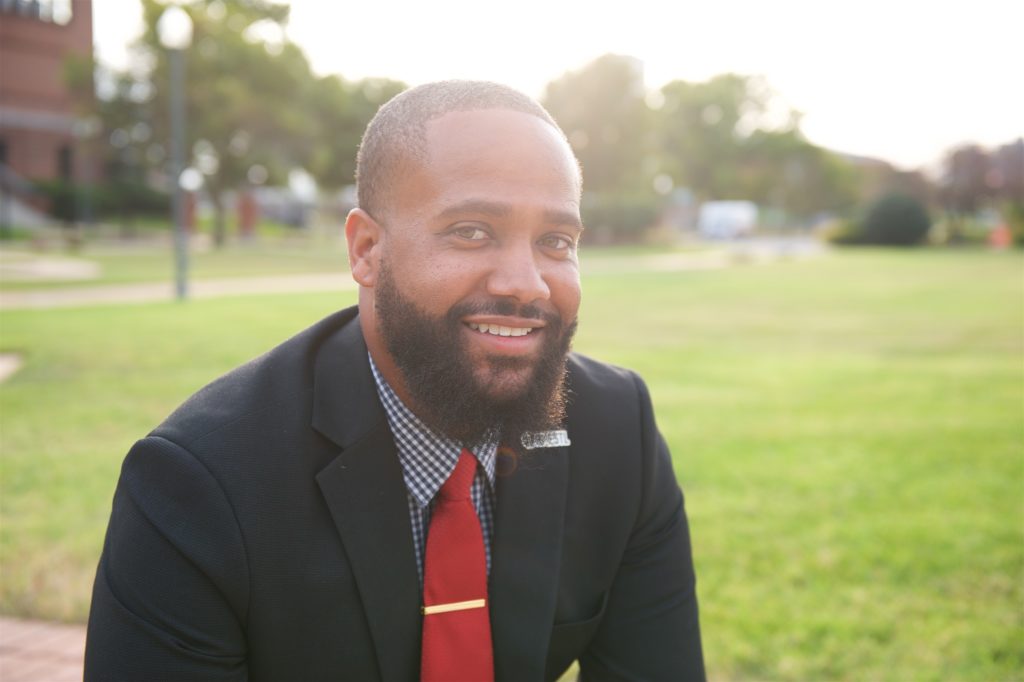
Dr. Howard Fields: My oldest son is 10 years old, and he’ll be 29 by 2039. By far, the most difficult text I’ve ever received while on the job was from my son. It occurred about three weeks ago and it read, “Daddy, I’m scared.” Now, for context, my kids are learning virtually during the pandemic. Well, for one of his assignments, I allowed him to research something he’s passionate about. A day into his research was when he texted me that message. When I asked him, “What’s going on?” he said, “Tamir Rice was 12 years old.” He named all of these kids who were so young and he said, “I don’t want anything to happen to me. I don’t know what I’m supposed to do when I go out.” So I left work, brought him lunch, and we had a really good conversation. Multiple conversations now. I’ve learned and watched my son, even at 10, become increasingly passionate about what he calls “true liberty and justice for all.” It is because of this and so many other instances when I see young people using their voice and influence to enact positive change that I feel very optimistic about where we will be as a society by 2039.
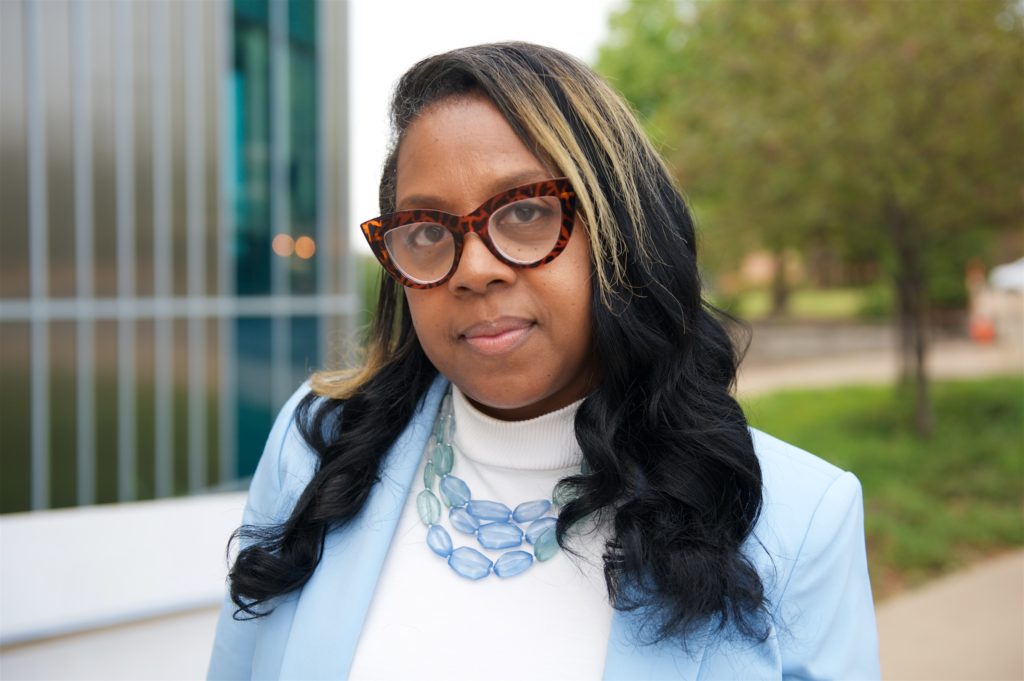
Dr. Nicole Evans: If I had to go with what young folks are doing now, and that’s creating hashtags, I would create a hashtag for my granddaughter. And it would be #NotMyGeneration. That would be the hashtag for my three year old granddaughter. That the things that are happening now will not happen in her generation. I too have stories of my children who were students over 15 years ago. As I hear Dr. Field’s story, I recall that I was having some of those same conversations with my Black sons. If it was in my father’s generation, my generation, my children’s, and now again in Dr. Fields’ son’s generation — for my granddaughter, it’s got to be that hashtag. So what I hope in 2039 is that it doesn’t matter where you live in the City of St. Louis or anywhere else — you will be getting a free, high-quality education. It shouldn’t have to be through a private school. And students can depend on it when it comes to receiving an education that will allow them to reach their fullest potential. The person who has the cure to cancer, to COVID, is sitting in our classrooms today. But if they don’t have the right support and the educational foundation, it is going to lay dormant. So what I want for 2039 is that every student will be able to reach his or her fullest potential after being guided by high-quality educators, that Racial Equity is attained, and that race is not a barrier for them. We will have eradicated racism.
Dr. Howard E. Fields III
Assistant Superintendent of Human Resources in the Kirkwood School District, Co-Founder of Black Males in Education St. Louis, and Adjunct Professor at Harris-Stowe State University
Dr. Nicole E. Evans
Executive Director of Urban Education and Student Engagement at Harris-Stowe State University, Partner and Chief of Leadership and Development for Equitable Education Consultants, and Leadership Coach and Facilitator for Embracing Equity


